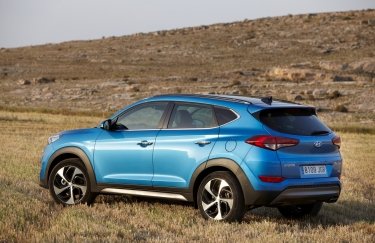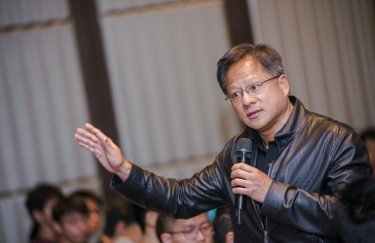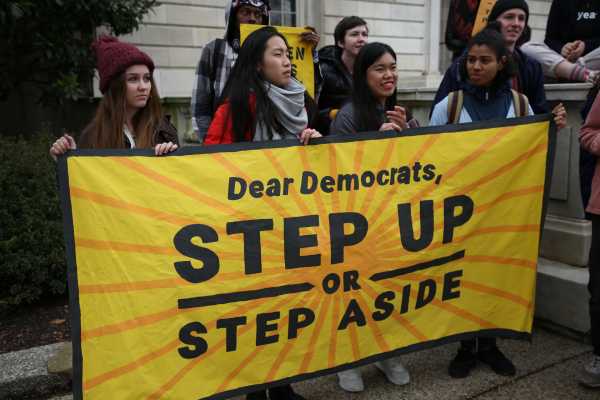
Share
Tweet
Share
Share
The Green New Deal, explained
tweet
share
If the recent report from the Intergovernmental Panel on Climate Change is to be believed, humanity has just over a decade to get carbon emissions under control before catastrophic climate change impacts become unavoidable.
The Republican Party generally ignores or denies that problem. But the Democratic Party claims to accept and understand it.
It is odd, then, that Democrats do not have a plan to address climate change.
Their last big plan — the American Clean Energy and Security Act — passed the House in 2009 but went on to die an unceremonious death before reaching the Senate floor. Since then, there’s been nothing to replace it.
Plenty of Democratic politicians support policies that would reduce climate pollution — renewable energy tax credits, fuel economy standards, and the like — but those policies do not add up to a comprehensive solution, certainly nothing like what the Intergovernmental Panel on Climate Change (IPCC) suggests is necessary.
Young activists, who will be forced to live with the ravages of climate change, find this upsetting. So they have proposed a plan of their own. It’s called the Green New Deal (GND) — a term purposefully reminiscent of Franklin Delano Roosevelt’s original New Deal in the 1930s — and it has become the talk of the town. Here are Google searches from the past few months:
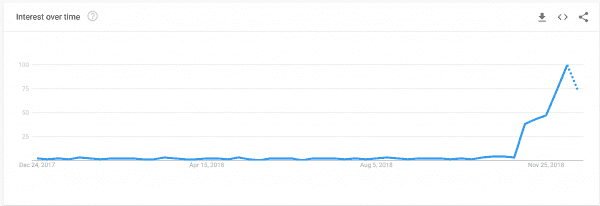
For this story, I talked to wonks and political activists who are working on the GND, and without exception, they expressed surprise at the speed and intensity with which both media attention and activist energy have centered on it. There is a sense among those involved that they have caught a tiger by the tail.
The GND push has thrust climate change into the national conversation, put House Democrats on notice, and created an intense and escalating bandwagon effect. Politicians (most recently 2020 presidential aspirant Cory Booker), advocates (most recently Al Gore), wonks, and activists — everyone involved in green politics is talking about the GND.
But … WTF is it?
As we will see, the exact details of the GND remain to be worked out, but the broad thrust is fairly simple. It refers, in the loosest sense, to a massive program of investments in clean-energy jobs and infrastructure, meant to transform not just the energy sector, but the entire economy. It is meant both to decarbonize the economy and to make it fairer and more just.
But the policy is only part of the picture. Just as striking are the politics, which seem to have tapped into an enormous, untapped demand for climate ambition.
When I think about the social status of the GND, I am struck by an analogy: It’s a bit like concentrated solar power. (I’m an energy nerd. Sue me.) In a concentrated solar power plant, large arrays of mirrors reflect sunlight onto a single tower, heating the fluid inside it. The fluid transfers heat to water, the steam from the boiling fluid drives a turbine, and the turbine generates electrical power.

The GND is the tower, and all the sudden, all the mirrors are aligned, focused on it. The heat is building, the water is rapidly reaching a boil. Meanwhile, its owners are racing to build a turbine.
There is immense potential energy in the GND, a concentration of social attention and intensity. But converting that heat to power — to real results on the ground — will involve a great deal of political and policy engineering, almost all of which lies ahead.
The GND has great potential, but then, American political history is a long story of wasted potential, of waves of progressive enthusiasm breaking on the rocky shores of Washington, DC, to no lasting effect. Whether that fate awaits the GND depends on many things, among them whether President Donald Trump — the culmination of a history of total Republican intransigence and ugliness the stretches over young activists’ entire adult lives — has changed the political landscape enough that Democrats might leave behind their long defensive crouch and voice some ambition.
Before jumping in, it’s worth noting that a number of great journalists have blazed the trail on this story already. See, in particular: Kate Aronoff’s work, here and here but especially, for the big picture, here; Hannah Northey and the crew at E&E are all over the daily developments; Alexander Kaufman at Huffington Post keeps track of the politics; and Rob Meyer at the Atlantic always has good thoughts. (There are no doubt many others I’m forgetting.)
To get a handle on the GND, let’s take a spin through its history, the role it’s playing in current politics, the effort to back it up with a real policy program, and the many, many challenges facing it before it can become legislation.
The GND concept is not new
The first use of the term “GND” in the US may trace to New York Times columnist Thomas Friedman, who called for one in a 2007 column (and in his book Hot, Flat, and Crowded) as a kind of green globalism. (Funny thing, politics.) As Kaufman notes in a story on this history, none other than Barack Obama was taken by Friedman’s idea and included a GND in his 2008 platform. (It can also be argued that Obama’s stimulus bill was a proto-GND in itself.)
Around the same time, in 2007, British economist Richard Murphy began discussing a GND and founded the Green New Deal Group, which funneled some ideas to the Labour Party. The UN also took up the idea, calling for a global GND in 2009.
But then Tories won in the UK in 2009, the Republicans swept the 2010 midterms, and the idea mostly went quiescent, at least among politicians.
In 2016, a GND became the centerpiece of the Green Party presidential campaign of Jill Stein; indeed, a GND has been part of the US Green Party’s platform for over a decade. (It is also central to the platform of the European Greens — see this study from the Wuppertal Institute.)
Bernie Sanders’s 2016 campaign included a GND. And then, in the 2018 midterms, Alexandria Ocasio-Cortez, now a representative-elect, took it up.
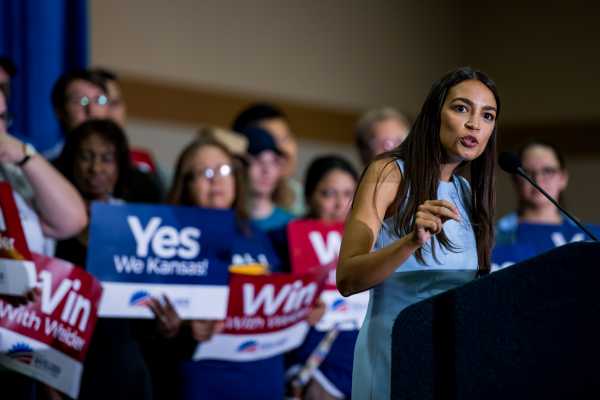
But that capsule history of the term itself, the brand, somewhat sells short the intellectual lineage. Many pieces of the GND have been worked on by many people over the years. The constituent ideas — 100 percent clean energy; a just transition to a new, better economy; massive public sector investments — are not new.
Talk of a “blue-green alliance” between labor and environmentalists, built around public infrastructure investments and new jobs, goes all the way back to 2000 presidential candidate Ralph Nader; real work has been underway at least since 2006, when the, er, Blue-Green Alliance was established. The AFL-CIO has its own big infrastructure plan.
Van Jones wrote a book about green jobs back in 2008 and even worked briefly as an Obama green jobs adviser, before a right-wing smear campaign drove him from the administration. The whole green-economy frame almost took root, but once the Dems went on the defensive in 2010, it faded to the background.
In Washington state this year, activists ran a ballot initiative that coupled a carbon tax with a GND-style program of investments, but, in the face of $30 million of oil money, it went down to defeat.
Nonetheless, the basic GND ideas have persisted. And their appeal only grew as climate warnings became more dire. They were in the collective water, like an oversaturated solution, just waiting for a particle around which to crystallize.
That particle came in November.
The GND comes to Washington
After the 2016 race, some of the folks who worked on the Sanders campaign started an organization called Brand New Congress, with the audacious (some might say insane) goal of recruiting 400 fresh new faces to run for, and take over, Congress. Part of the shared platform was an ambitious, WWII-style mobilization on climate change (though not yet branded GND).
That effort did not result in a congressional takeover, but it was not without fruits. Brand New Congress spun off a group called Justice Democrats that went on to recruit several winning candidates like Rashida Tlaib, Ilhan Omar, and Ayanna Pressley.
Among them was Ocasio-Cortez, the young bartender who ran against incumbent centrist Democrat Joe Crowley in the New York’s 14th District primary. The co-founder of Brand New Congress, Saikat Chakrabarti, became Ocasio-Cortez’s co-campaign manager. (As of January, he will be her chief of staff.) And Ocasio-Cortez, who was already committed to putting climate change at the top of her agenda, eagerly embraced the green mobilization plan and began using the GND branding.
Then came the first week of orientation for new members of Congress.
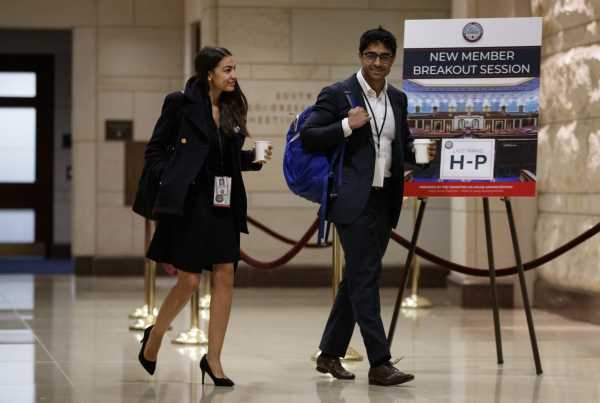
Several things came together that week. Shortly prior, the IPCC had released its latest report, with the ominous news that humanity has just over a decade to peak and begin rapidly reducing global carbon emissions if there is to be any hope of hitting the (already inadequate) international target of limiting global temperature rise to no more than 2 degrees Celsius.
There was already enormous energy and mobilization on the left, thanks to the election, and young activists were keen to push climate change to the top of the agenda.
Then a piece in the Hill reported that House Democrats had no plans to move on climate change, which appeared nowhere in their list of priorities. Meanwhile, House Minority Leader Nancy Pelosi started talking the day after the election about a “bipartisan marketplace of ideas,” which is not exactly what you’d call reading the room.
Pelosi signaled that she planned to revive the Select Committee on Energy Independence and Global Warming (2007 to 2011, RIP), but activists and the incoming class of social democrats wanted something much bolder.
They didn’t see any point in pursuing cooperation with Republicans, a strategy that has proven fruitless for a decade. And they didn’t want climate policy tucked away in a committee that would do nothing but hold hearings and discuss how real global warming is (spoiler: so real).
But it gave them something to ask for. They couldn’t very well demand the full GND before the new Congress was even sworn in. But they could ask for a commitment.
So the Sunrise Movement, a youth-led organization organizing around a GND, planned a sit-in in Pelosi’s office, to demand a committee with teeth — a committee that would be charged with actually developing a plan to meet the ambitious targets implied by the IPCC report.
Sunrise approached Ocasio-Cortez to ask if she might help publicize the event, perhaps with a tweet. Instead, she vowed to show up. She and her team had been casting around for some early way to push the GND into the public consciousness and onto the Democratic agenda.
Working together, Sunrise, Ocasio-Cortez, and the Justice Democrats quickly hashed out a proposal for a Select Committee on a Green New Deal, outlining their vision for the kind of plan such a committee would produce.
Sunrise brought close to 200 young activists to Pelosi’s office on November 13. Ocasio-Cortez, taking a break from orientation, stopped by to rally them and show her support. The media swarmed.
In retrospect, though it came together on the fly, the timing was fortuitous. The elections were over; there was no presidential election yet; Trump hadn’t tweeted in a few whole minutes; the political press was bored. The IPCC had put climate change in the news. And the prospect of a young, newly elected, not-yet-sworn-in progressive representative leading a youth protest against her leader-to-be proved irresistible.
In the ensuing weeks, Ocasio-Cortez and Sunrise pushed incoming members of Congress to sign on to the GND Select Committee plan. On December 10, there was another sit-in in Pelosi’s office, this time with activists stretched out the door. By the end, 40 members of Congress — including several notable senators like Booker, Sanders, and Jeff Merkley, each a potential 2020 presidential candidate — signed on to support the committee.
It was an activist campaign building momentum for serious climate action, and it was making headlines.
Dem leadership gives activists the stiff arm
Nonetheless, it seems Democratic leadership was not particularly happy about a group of upstarts laying claim to a major issue and instructing the caucus how to approach it. Pelosi largely gave Ocasio-Cortez and activists the cold shoulder. They were not warned before Steny Hoyer announced on Wednesday that the committee will not have subpoena power. And they were not warned before it leaked on Thursday that Rep. Kathy Castor of Florida had been chosen to head the committee, which would in fact be the same old select committee on climate change.
As for the GND? “I think they have some terrific ideas,” Castor said, all but patting activists on the head. “But that’s not going to be our sole focus.”
What about the activists’ other major demand, that no one who accepts fossil fuel money be allowed on the committee? “I don’t think you can do that under the First Amendment, really,” she said.
She later admitted to Kaufman at the Huffington Post that this peculiar bit of constitutional interpretation was “inartful,” and she just doesn’t know if she can do that as chair of the committee. She says maybe she’ll talk it over with the caucus.
This is a clear rebuke from Pelosi and Hoyer, not only cutting short a growing activist campaign, without warning, on the eve of the holidays, but also appointing a committee chair who isn’t briefed on the debate around the committee, is reliable but undistinguished on environmental issues, and clearly hasn’t been prepared for the activist fury that awaits her. (It doesn’t seem particularly fair to Castor, either.)
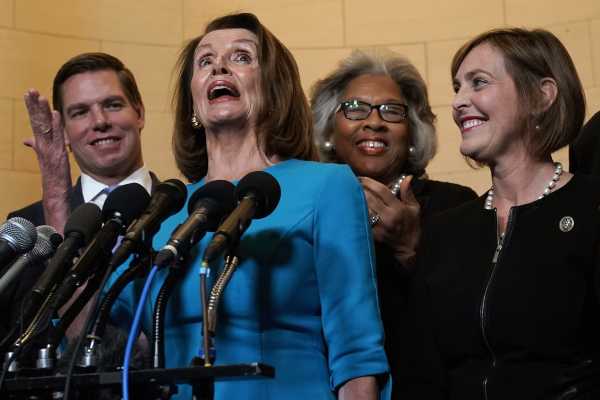
“They’re not willing to go out on a limb unless they’re confident that they have the full support of the caucus,” says Evan Weber, a co-founder of Sunrise, “which for us is disappointing but not all that surprising.”
“What we thought was, let’s try to get the smallest possible thing done, which is get all Democrats to agree that we should make a plan,” says Chakrabarti, but even that “isn’t so easy.”
Here’s a revealing fact about this clash.
Though Chakrabarti may consider it the “smallest possible thing,” anyone who glances at Ocasio-Cortez’s document will realize that it is far from small or easy. It doesn’t just call for a committee. It says that no one who receives any fossil fuel funding may serve on the committee (which would rule out a good swath of senior Democrats).
It requires that the committee produce a plan that fully decarbonizes the economy, invests trillions of dollars, and provides a federal job guarantee, while addressing and mitigating historical inequalities. (Oh, and it might also include such “additional measures such as basic income programs [or] universal health care programs.”)
In short, it charges the committee with developing a plan of vaulting ambition and complexity. If representatives were mainly focused on policy, some might have raised cautions along these lines.
But neither Chakrabarti and Weber has heard any policy objections. No one has asked about, say, the federal jobs guarantee. Rather, the objections have been almost entirely about turf.
As Weber says, “certain politicians who were not excited about any select committee” claimed that the committee’s jurisdiction would override the jurisdiction and authority of existing committees.
The proposal never meant to assign the select committee the power to introduce legislation, Weber says, but to make members more comfortable, language was added clarifying as much. The committee could only produce a plan, as draft legislation for other committees to take up or not as they see fit. “For us,” Weber says, “the more important thing for the draft legislation was always to have a platform for candidates to run on in 2020.”
But in the end, the dispute was less about concrete issues of jurisdiction than a message to newcomers. As E&E reports, “many Democratic lawmakers say the panel could be a landing place for many of the freshmen members who have said they’d like to be on Energy and Commerce.” The youngsters can have a committee to hold hearings and make headlines. As for legislation, we adults have got that covered.
Would Ocasio-Cortez accept a spot on the committee? “She doesn’t want to be on a committee just for the sake of being on a committee,” says Chakrabarti.
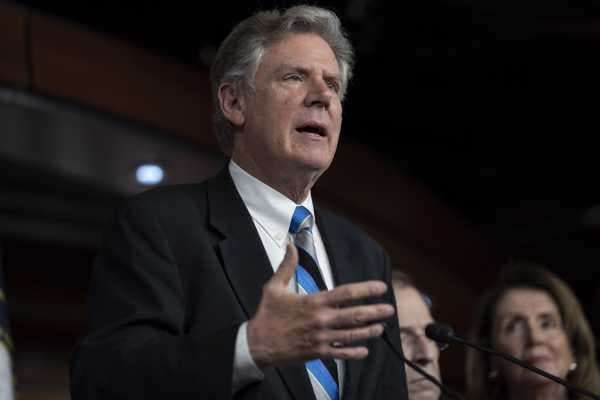
What’s next for the GND
Though the committee fight was discouraging (and not everyone agrees about its tactical wisdom), its reverberations reached well beyond DC. It produced an enormous jolt for the movement.
All the sudden, the left has found something it had lacked for years: an ambitious, positive climate program, something as bold and catchy as “Medicare-for-all” in health care. Advocates and activists are on board and wonks are thinking about the mechanics.
“We thought it would take a year” to get a movement going around the GND, Chakrabarti says. Instead, “it took weeks.”
Leaders have a few ideas about what to do next, including the possibility of a GND caucus in the House (after all, the membership has already mostly identified itself) and continued direct action.
But the top priority after the holidays is to begin the process of putting real policy meat on the GND bones — hammering out an actual policy platform.
“If they’re not going to develop the plan,” Weber says. “We will. We’ll get together the scientists, the engineers, the community leaders, the mayors and city councilors, create the plan ourselves, and go out and build the public and political support to make it happen over the next two years.”
As Weber concedes, “GND” can mean just about anything at the moment. Now the race is on to make it mean something in particular — to produce something that activists and wonks can agree on, that politicians can run on, and that the public can rally around.
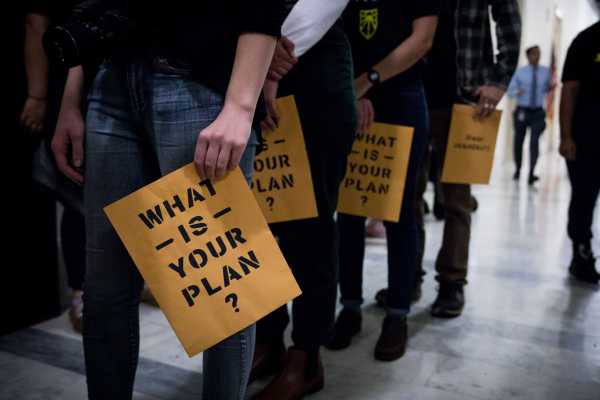
A new think tank will transform the GND into a policy platform
As of now, the movement’s only “official” version of the GND is the Ocasio-Cortez document. As sweeping and ambitious as it is, it is less a policy platform than a set of high-level goals. Each one (e.g., “decarbonizing, repairing, and improving transportation and other infrastructure”) would entail dozens of policies, at different levels of government.
The first and thus far only serious effort to fill out the policy side came in a report from Greg Carlock at the upstart think tank Data For Progress. But even that report is less a specific set of policy choices than an extensive policy menu — a set of options for each of the program’s large-scale goals, everything from building standards to new techniques in agriculture to investments in transit. It is something like a detailed snapshot of the policy landscape, from which an architect could bricolage together a plan.
It is also a narrative tying those goals together, and its central theme — the central theme of all contemporary GND work — is that the GND is not just a climate change policy. It is a vision for a new kind of economy, built around a new set of social and economic relationships. It is not merely a way to reduce emissions, but also to ameliorate the other symptoms and dysfunctions of a late capitalist economy: growing inequality and concentration of power at the top.
“Climate change is an emergent property of a bad economic system,” Carlock says. That outmoded economic system — the nebulous set of assumptions and power relationships that goes under the name “neoliberalism” — is the real target of the GND.
The GND is, at its heart, a form of social-democratic populism. Its intent is to involve the entire citizenry in the shared project of adapting to the 21st century, and in so doing materially improve the quality of life of the poor and middle class. It is an attempt to rebalance the economy and the political system, away from a monomaniacal focus on private goods, toward a more generous view of public goods and public purpose.
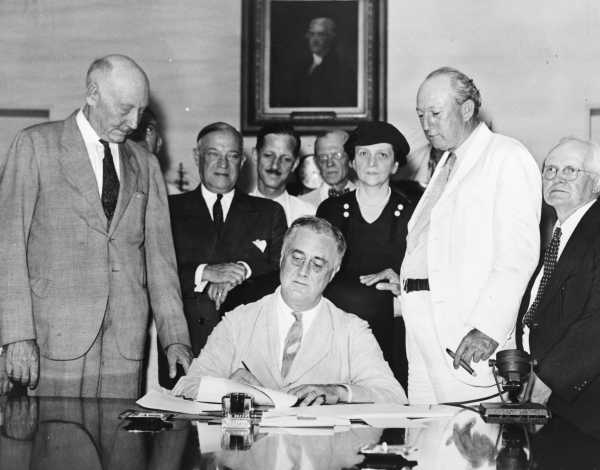
At least that’s the idea. But getting from that idea to concrete policy platform that diverse constituencies can rally around (and a broad array of Democrats can endorse) will be a delicate and charged undertaking. Making those fraught policy choices is largely going to fall on the shoulders of a young policy analyst whose name I suspect you will be hearing much more of: Rhiana Gunn-Wright.
Gunn-Wright, who served as policy director on the insurgent gubernatorial campaign of Abdul El-Sayed in Michigan, works for a relatively new policy shop called New Consensus, which spun off as the policy arm of Justice Democrats. At least through 2020, its sole focus is to put together a policy platform that Democrats could, in theory, pass into law in 2020. (Northey has a good story on New Consensus.)
Organizer Demond Drummer will serve as the executive director, but Gunn-Wright will lead the GND effort.
Obviously, figuring out how to fundamentally transform the world’s largest economy is a lot for one person to take on. When I asked Gunn-Wright if she knows what she’s gotten into, she laughs. “It’s really exciting!”
I heard grumbling here and there about the responsibility for policy being given over to a new shop, rather than to the many people and organizations that have been working on these issues, but Gunn-Wright is at pains to explain that she is not setting out to write a GND on her own.
“This requires an incredible amount of policy knowledge, more than one group, definitely more than one person can bring to bear,” she says, “so the hope is that it can be a foundation for supporting research.”
The idea is to convene experts and activists to hash out a shared vision, prescriptive on some matters, but offering a menu of options on others. The result will be a platform, a way of using “policymaking as a form of organizing,” so that even wonks doing deep work on a particular piece or activists rallying around an individual battle can be “connected to the larger framework and plan,” she says.
Above all, she says, New Consensus is eager to “move forward in communication and in alignment.”
When I noted that the transportation goals in the GND so far have been pretty broad and aspirational, Gunn-Wright made it clear that these issues have been on her mind lately.
“What does it mean for light-duty electric vehicles?” she asked. “How are we dealing with aviation? How are we dealing with shipping? Where do hydrogen fuel cells fit in? How are we getting states to get together and get fleets big enough to do these deployments? How are we dealing with school buses?” (This went on for several minutes.)

Or how about electricity? Currently, Gunn-Wright said, New Consensus is “partnering with some analysts to model what it looks like if you have a national [renewable portfolio standard] and a carbon tax. How do those two things interact? What’s the effect on emissions? What is the economic effect?” (This too went on for several minutes.)
I delighted in the wonkery, but Gunn-Wright also returned the conversation again and again to the effects of the program on ordinary people, especially the poor and vulnerable. “I spent a little bit of time as a [user experience] researcher,” she says, “so my team also thinks about the end user.” How does the average citizen find a suitable job, or get help putting solar panels on their roof?
“If you have more money or access to power, you can either opt out or pay to make it simpler,” she says. “The people who will have to go through all the mess are generally poorer people, with the least access to power.”
Gunn-Wright’s command of the issues, coupled with her unapologetic belief in the public sector to “shape markets and direct innovation,” coupled with her evident concern for the low-income and working classes, make me excited to see what New Consensus produces.
Yet it remains an almost outlandishly ambitious undertaking: to coordinate and develop a coherent policy platform that can guide a transformation of the economy, decarbonize every economic sector, guarantee every American a well-paying job with good benefits, strengthen the resilience of the country’s most vulnerable communities, command the support of politicians from every region of the country, and inspire enthusiasm and action among activists.
But Gunn-Wright is optimistic. “I’ve never worked on a policy issue where I was met with so much good will, people who will share information, people willing to leverage their talents and have conversations,” she says. “That gives me a lot of hope.”
So it still remains to hammer out a specific GND. But that doesn’t mean there’s no substance to it at all. At least among the movement around Sunrise and Ocasio-Cortez, there is a substantial degree of consensus about the core elements.
The three core principles of the GND: decarbonization, jobs, and justice
I asked the same question of everyone I talked to: What are your bottom lines? What must be in a policy platform for it to earn the name GND? Answers varied considerably in their details and emphasis, but they clustered around three basic principles.
1) The plan must decarbonize the economy.
The young people who will have to live with the effects of climate change want a plan that begins with what is necessary rather than what is deemed politically possible. “We want the policy to match the findings in the IPCC report — to match the scale of the problem,” says Waleed Shahid of Justice Democrats. Or as Gunn-Wright puts it, “We need to go all the way.”
That means decarbonizing the US economy: getting the electricity sector to zero carbon as soon as possible and other sectors shortly thereafter. That is a gargantuan undertaking that will touch every American life.
Ocasio-Cortez’s platform calls for 100 percent renewable electricity within 10 years, but very few policy experts believe that is possible. Carlock, along with most other wonks in the field, thinks it’s preferable to shoot for 100 percent “clean and renewable energy,” to make room for non-renewable carbon-free options like existing nuclear plants or any new developments in nuclear, biomass, or carbon capture and sequestration. And they also think it’s best to push the target out a bit. (Carlock has it at 2035.)
Other energy applications will be even more challenging than electricity. Decarbonizing transportation will involve radically accelerating the spread of electric vehicles, possibly by banning gasoline and diesel vehicle sales by 2030, and figuring out what to do with aviation and heavy transport.
Buildings produce about 40 percent of annual US carbon emissions. Decarbonizing buildings will involve implementing zero-carbon standards for all new buildings and funding the wholesale retrofitting of existing buildings, millions of which use fossil fuels like natural gas for heating and cooling.
Then there’s heavy industry, where decarbonization remains something of a mystery, the work barely begun.
And on and on. Ocasio-Cortez’s plan actually calls for decarbonizing not just electricity but the entire US economy in 10 years, which is almost certainly impossible absent radical reductions in Americans’ energy consumption, something like imposed austerity — and nobody thinks Americans are that scared of climate change. Even decarbonizing the economy by 2050, as Carlock’s report calls for, is an extraordinarily daunting challenge, involving hundreds of discrete policy problems, each facing their own dilemmas and entrenched interests.
2) The plan must include a federal jobs guarantee and large-scale public investments.
Again, the GND is not just climate policy. It’s about transforming the economy, lifting the up the poor and middle class, and creating a more muscular, active public sector.
The GND “opens an opportunity to renegotiate power relationships between the public sector, the private sector, and the people,” says Gunn-Wright. “We are interested in solutions that create more democratic structures in our economy.”
Weber says that the key is to “connect [the GND] inextricably to the economic pain that so many Americans still feel, and show people that there’s a way to build a better economy and improve their lives through action on climate change.”
To that end, the GND would involve large-scale investments, on the order of trillions of dollars over 10 years, alongside a federal jobs guarantee. A job paying at least $15 an hour, with good benefits, would be available to anyone who wanted one.
Politically, this is the key to the GND. It’s a program that can involve everyone and help everyone — and, theoretically, gain support from everyone, even those in red states who do not care about climate change. The investments and the job guarantee take the GND out of the realm of environmental policy and move it into the realm of transformational economic policy.

But policy-wise, this is also, in many ways, the least cooked piece. The federal job guarantee has substantial support among wonks (here’s an argument in favor from scholars at the Levy Economics Institute), but also a good bit of opposition. (Matt Bruenig runs through some of the objections; Josh Bivens of the Economic Policy Institute argues for other ways of reaching full employment.)
The way to think about the basic problem is: You’re attempting to train and employ everyone who happens to want a job at the moment — a constantly fluctuating flow of people with differing skills, who will need jobs for differing periods of time. You’re trying to provide those jobs through a massive program of investments. But what sorts of investments provide work for a job force of perpetually shifting skills and composition? Specifically, what subset of those investments are both “green” and suitable for a morphing, countercyclical job force?
It’s not as easy to spend money and employ people as it might seem. Carlock has numerous investment ideas in his report (stuff like brownfield restoration and tree-planting), but even if enough ideas can be found, administration, which would be spread out in state offices and community centers across the country, remains daunting.
“The idea that thousands of administrations across the country will be able to usefully employ random flows of labor with random sets of skills in random durations is fairly implausible,” argues Bruenig.
Gunn-Wright notes that there are many paths to a jobs guarantee, some incremental. Both the jobs and investment pieces could be phased in, expanded through testing and experimentation. “Pilot and scale,” Carlock says.
Still, at the very least, there’s a good bit of policy work ahead for this (politically central) element of the plan to become practicable legislation.
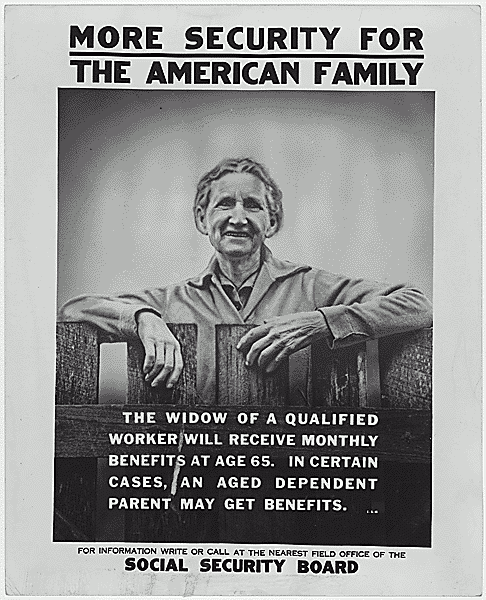
3) The plan must include a just transition.
Several people I talked to stressed that they want to avoid the mistakes of the original New Deal, many elements of which entrenched or exacerbated racial inequalities. Everyone wants to make sure that the plan includes protections for those hardest hit by historical discrimination and those set to suffer most from the effects of climate change — in Ocasio-Cortez’s document, “low-income communities, communities of color, indigenous communities, [and] the front-line communities most affected by climate change, pollution, and other environmental harm.”
Part of that is workforce training and the job guarantee, part of it is ensuring that all those jobs come with strong labor, environmental, and nondiscrimination standards, part of it is investments in those communities to fund programs like lead remediation, and part of it is making sure that all the investments — that all parts of the GND — follow strong environmental-justice standards.
Beyond these three core principles, the GND is still capacious enough to include a wide variety of preferences and perspectives. Journalist Aronoff best expresses the maximum, self-avowedly socialist version, painting an idyllic picture of a family provisioned with publicly funded work, child care benefits, and elder care. The Sierra Club has a somewhat more modest version.
As the GND brand spreads, traditional advocacy and policy groups are likely to break off more manageable chunks under the same rubric. After all, the GND is so sweeping that virtually any climate policy can claim to be part of it.
The delicate dance is to keep the GND fuzzy enough to allow a broad coalition of people and interests to see themselves in it — which is, somewhat miraculously, what seems to have happened so far — while specifying it enough to avoid having it watered down into a feel-good buzzword.
And that has to be done while navigating all the prodigious challenges ahead.
The top three challenges facing the GND: paying for it, convincing the public, and winning over Democrats
As you’ve probably gathered by now, the GND is much more ambitious than most policy ideas that have been bouncing around Washington, DC, the past few decades. Moving it from idea to legislation will involve overcoming obstacles almost too numerous to list.
Because the GND is, at its core, an argument for radical change, it is certain to inspire reaction — a defense of the status quo. And as Albert Hirschman wrote in his 1991 book The Rhetoric of Reaction, the arguments will cluster around the three core reactionary themes (quoting Hirschman): “futility — the claim that all attempts at social engineering are powerless to alter the natural order of things; perversity — the argument that interventions will actually backfire and have the opposite of their intended effect; and jeopardy — the idea that a new, possibly more radical reform will threaten older, hard won liberal reforms.”
Those arguments will take innumerable forms. I will focus on one key question the movement must answer and two key constituencies it must win over.
1) “How are you going to pay for it?”
The first and most persistent question facing any social reform in the US is how it will pay for itself. The right has spent more than half a century in the US waging a propaganda campaign intended to convince Americans of a few key things: 1) the federal budget must be balanced, with every dollar spent “paid for” with a dollar of revenue raised, lest inflation destroy us all; 2) taxes are high and burdensome and any effort to raise taxes is, de facto, bad; 3) government is incompetent and its spending is always wasteful; and 4) America is broke, in debt, with crippling liabilities coming due soon.
To be clear, all four are false. They are pernicious myths, motivated by the desire to prevent progressive social reform. They are, to use a technical term, bullshit.
But they are, nonetheless, widely accepted bullshit that shapes the US political economy. Indeed, they have been repeated so often, for so long, that they have permeated the establishments of both parties and shaped the folk political theories of the average American. Stop a random person on the street and they might not know much about politics, but they will be certain that the country is in debt and can’t afford nice things.
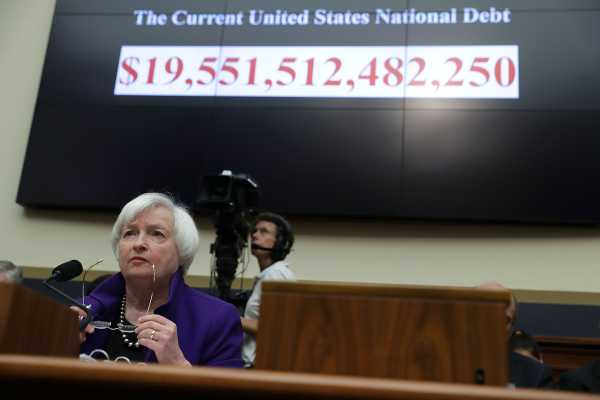
Countering the “pay for it” question can be done in several ways. One, which Ocasio-Cortez has practiced herself, is to point out the hypocrisy. When Congress funnels trillions to the military or cuts taxes for the wealthy, no one asks how they will pay for it. Pay-for demands seem only to apply to Democrats, and only for social spending.
The second is to point out that climate change impacts are going to cost more than climate mitigation anyway. The GND is big, but “big things will happen,” says Chakrabarti. “The two options are, either we’re going to intentionally do the big things we want, or big things we don’t want will happen to us.”
The third is to point out that there are options for raising revenue. There’s a carbon tax, obviously — the GND movement is opposed to carbon pricing-only strategies, but they all acknowledge a role for pricing — but Gunn-Wright also mentions a financial transactions tax and pulling some of the returns of large government investments back in as revenue. More recently, in an interview with 60 Minutes, Ocasio-Cortez mentioned restoring income tax rates of up to 70 percent on the ultra-wealthy as a way of raising revenue. “That doesn’t mean all $10 million are taxed at an extremely high rate, but it means that as you climb up this ladder you should be contributing more,” she told Anderson Cooper.
The fourth, and boldest, is to reject the question entirely.
There is great enthusiasm on the left right now for Modern Monetary Theory and related ideas and scholars. (Vox’s Dylan Matthews wrote a great explainer on Modern Monetary Theory a few years ago, and another more recently about Bernie Sanders’s adoption of the idea.) The core ideas are fairly simple.
If the question is what the US can afford to invest, the way to think about it is not in terms of how much money the country has. It literally has as much money as it wants. It prints its own money! (The US has a “fiat currency,” in the lingo.)
The US government can spend all the money it wants. What ultimately sets the limits on America’s ability to invest are its resources. It has so much labor potential, so much natural resources, so much manufacturing capacity, etc. By paying for stuff, injecting money into the economy, the government puts those resources to work.
If the economy overheats, one or more of those resources nears its limits, scarcity drives prices up and inflation ensues. To stop short of that, the government can pull some money out, by scaling back programs or raising taxes. Taxes are simply a way of extracting money from the economy.
Stony Brook University professor Stephanie Kelton (a Modern Monetary Theory guru, Sanders adviser, and likely GND adviser in some capacity, at some point) calls it an economy’s natural speed limit. As long as the economy stays under that limit and avoids inflation, the government can spend more money. A deficit isn’t a bad thing, it’s just a foot on the accelerator.
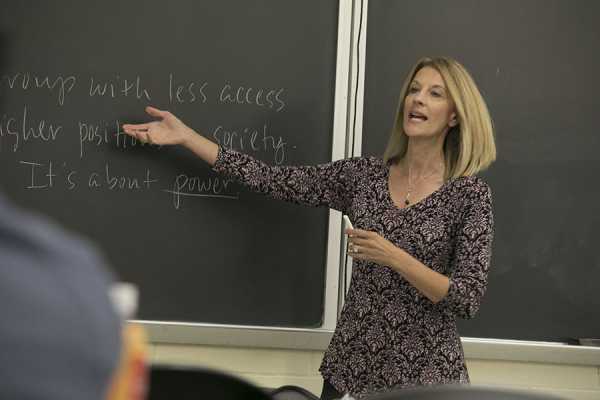
The notion of balanced federal budgets — which Democrats adopted as their own under Obama through the absurd “PayGo” rules, and look likely to adopt again next session — amounts, Kelton says, to a promise: “I’m going to take a dollar out of the economy, usually in taxes, for every dollar I plan to put in.”
But why would you do that? Why would you slow the economy a bit for every bit you boosted it?
“If the deficit has to be 4.7 percent of GDP to create the economy we want, with full employment, low inflation, and poverty going down,” she says, “who cares? If we can create the economy we want with a deficit of 2.1 percent, that’s fine too. The budget outcome isn’t the thing that matters, it’s the real economic conditions.”
The way to approach a GND, she says, is to adopt the method of economist John Maynard Keynes in his book How to Pay for the War: Model the economy’s available resources; figure out what you can deploy and still avoid inflation; figure out how much private consumption spending you have to displace to make room for the necessary war spending; and finally, ensure a just transition, i.e., make sure that the poor and middle class, the ones deferring their private consumption spending, are rewarded for their sacrifice. (That’s what US War Bonds were about.)
Winning that argument — convincing Americans that it’s the economy, not the budget, that needs to be balanced — is an uphill battle, to say the least, lifting a lot of historical baggage.
One way or another, GND proponents will relentlessly face, from both sides of the aisle, the question: How will you pay for it? Whatever their answer, they had better get it worked out, because the attacks are already incoming.
2) Winning over the public
GND proponents tout polling showing that majorities of the public support a green job guarantee and other elements of the GND.
Data for Progress has done extensive polling on a green jobs guarantee. It has found that a green jobs guarantee outpolls a straight jobs guarantee, especially among young people. It even brings Trump voters almost (but not quite) up to majority approval.
More recently, the movement has been excited about a recent survey from the Yale Program on Climate Change Communications, which shows that a GND commands majority support even from Republicans.
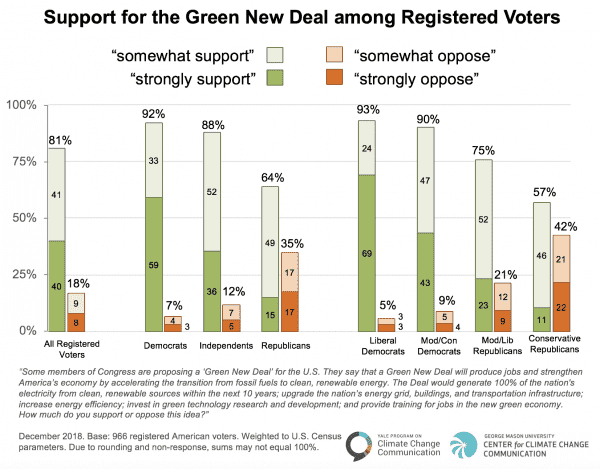
“Green jobs are overwhelmingly popular with voters. This is the future,” says Data for Progress co-founder Sean McElwee. “The question is not if we get a Green New Deal. We will have a Green New Deal. The question is how much beautiful socialist bullshit we get out of it after we wrestle with the Blue Dogs.”
It is true: In terms of public opinion, this is an incredibly strong position from which to start. The headline features of a GND sound bold and forward-looking and people generally react well to them.
Nonetheless, having seen countless polls come and go over the years, I have a few rules of thumb. First, people like good things and will react positively to them in polls. Look at the Yale survey question: “produce,” “strengthen,” “upgrade,” “provide.” Those are good things. Of course people want them! They want more health, more benefits, better wages, cleaner energy.
Conversely, if you poll bad things, like taxes, increased costs, bureaucracy, government control over private decisions, and wasteful spending, people react badly. (Data for Progress says it is in the process of testing the green jobs guarantee against negative framing language.)
People don’t have deep or settled views on most things and generally respond to identity cues, associations, and above all, messengers. In a poll, you take the messenger out of the equation and provide carefully curated cues. That tells you almost nothing about how people will get information or make decisions in the real world.
In the real world, if the GND looks like it has any chance of becoming a reality, it will face a giant right-wing smear campaign, coordinated across conservative media, think tanks, and politicians, funded by effectively unlimited fossil fuel wealth. The right will rush to define the GND as a silly, ridiculous, naive, unaffordable government boondoggle meant to destroy your way of life and funnel your taxpayer money to Democratic constituencies like illegal immigrants.
And keep in mind, the right-wing machine does not have to win that messaging battle. It just has to fight it, furiously, enough to make the GND controversial, to polarize the issue and freeze it in the same paralysis that grips the rest of US politics.
As Joe Romm of ClimateProgress points out, the most important finding in the survey is this one:
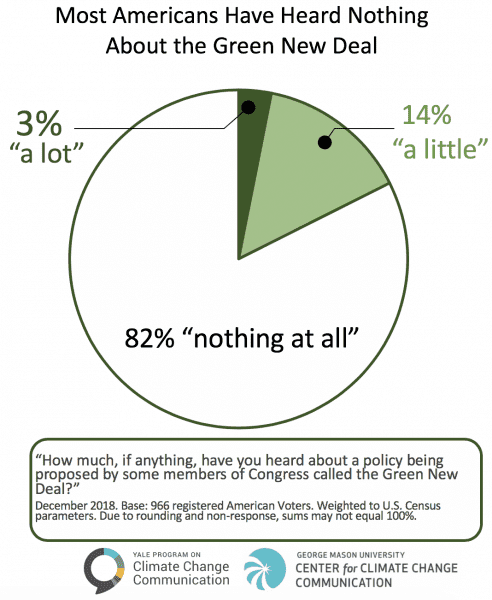
Virtually no one has heard of the GND. Right now, in the minds of the vast majority of Americans, “GND” signifies almost nothing. The task of defining it for them lies entirely ahead.
Advocates will work to define it with positive imagery. But they will not have the field to themselves. And they will likely never have access to the kind of money fossil fuels can spend to crush them. If they win the messaging battles to come, it will be with people power and media savvy.
3) Winning over Democrats
Veteran Democrats like Pelosi and Hoyer came of age in an era in which Democrats were on the defensive. Bill Clinton won with a “third way,” pledging fealty to markets and an end to big government. Ever since, Democrats have been backing into progress, moving incrementally, accepting basic conservative critiques of muscular social democracy.
And as the Republican Party has become more rabidly conservative and corrupt, congressional Democrats have developed a particular culture. They see themselves as the Good Guys, the ones who still care about good government, fiscal responsibility, and bipartisanship. They are loathe to break norms the way the GOP routinely has. They don’t want to fight dirty.
More than anything, it is that culture of caution and manners with which GND proponents must contend. The idea of adopting bold policy pledges with no care as to whether they draw any bipartisan support is deeply alien to congressional Democrats. They live in fear of Republican attacks, which are faithfully echoed throughout DC media. They don’t want to “stick their heads up” or “give Republicans ammunition.” They are hoping, on some level, that if they keep their heads down and don’t distract anyone, voters will focus on how much they don’t like Trump.
“Even the most progressive of the progressives suffer from a certain Stockholm syndrome from living under neoliberalism for 40 years,” says Chakrabarti.
But there is no way to soft-pedal something like the GND. There is no way to pretend that it is incremental or fully “paid for.” There is no way to pretend that GOP leadership, so deeply in hock to fossil fuel funding, is going to offer any kind of support for any part of it.
The GND offers Americans a bracing new alternative, not a hesitant step forward — a rejection of Republican dogma and fossil fuel energy, not a compromise with them. To rally Americans behind it, Democrats will have to “paint the picture and the vision,” Chakrabarti says. “You have to sell the American people that this is possible to make it possible.”
More than any process or jurisdictional issue, this is the choice that will face Democrats in coming years: to respond to Trump by promising a return to ordinary politics, or to respond to Trump by promising to strive for something genuinely new and better.
“What does America get if Dems take power in 2020?” Chakrabarti asks. “Either that can be a boring, crappy vision that no one’s going to get excited by, or it’s going to be an exciting vision that people will want to come out and vote for.”
The activists who have kickstarted this unlikely movement are well aware that they are the underdogs in this fight. The GND “would be a direct blow to some of the wealthiest and most powerful interests in the world,” says Weber, “and they’re not going to accept it lying down.”
He knows that tons of fossil fuel money is gearing up to descend on the movement. And he knows that Democrats will be difficult to rouse. He knows that even if Dems take power in 2020, any legislation will eventually have to contend with the Senate, where the Energy and Natural Resources Committee will be run by West Virginia’s Joe Manchin, who literally shot the last climate bill (which was a hell of a lot less ambitious than a GND).
“Even if we get the politics right, I still think that we’re going to need sustained mass protest, extended labor shutdowns, and general strikes to begin as soon as possible after Election Day 2020,” says Weber. “That’s going to take convincing the American people that this is an absolute moral and economic necessity, and the only thing standing in the way of it happening is the political class.”
It is a long shot. But as the IPCC has made clear, long shots are the only shots left. It is not the elderly members of Congress who will live with the havoc forecast by climate scientists, it is the young activists who are amassing on their doorsteps and in their offices. Those young activists are looking ahead further than the next election cycle. Their families will suffer the consequences of these choices.
But they believe that history is on their side. “The most powerful force known to humans is ideology,” says McElwee. Republicans have pushed through “radically unpopular policies because of their commitment to ideology.” But today, he says, “young people have the ideas that people want to be associated with. We shape ideology and that’s incredibly fucking powerful.”
Climate politics is, now as ever, a choice between changes that seem impossible and a future that seems unthinkable. For years, US politics has denied and avoided that choice. In their own way, Democrats — the “adults” who want to reserve the power to make these decisions — have avoided it just like Republicans.
Facing it squarely means radicalism. Now, a real response to climate change, a response on the scale of what the crisis demands, is on the table. It is an option. It has a name.
Whether America can work its way past polarization, paralysis, and structural barriers to change to actually grasp that option, to take a leap into a new future, very much remains to be seen. But there can be no more ignoring the choice.
Sourse: vox.com
